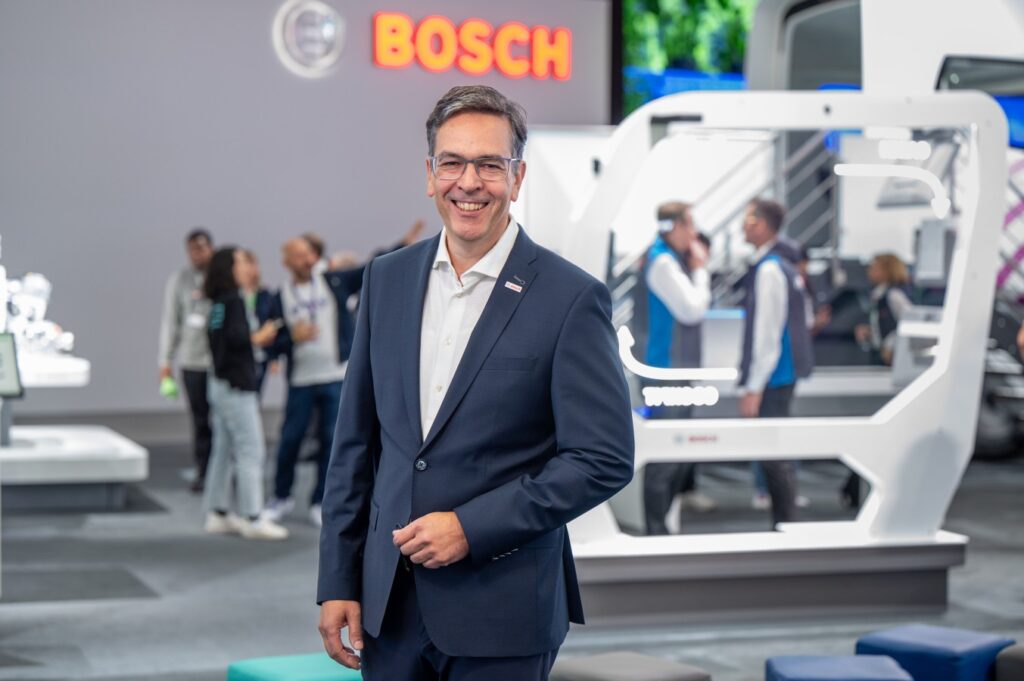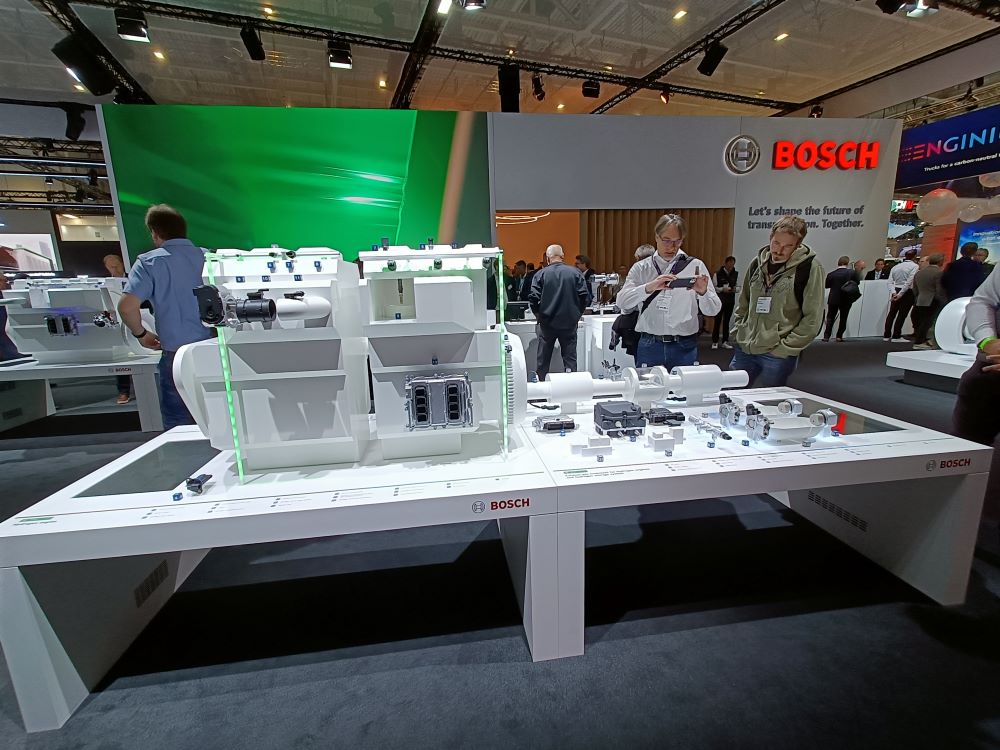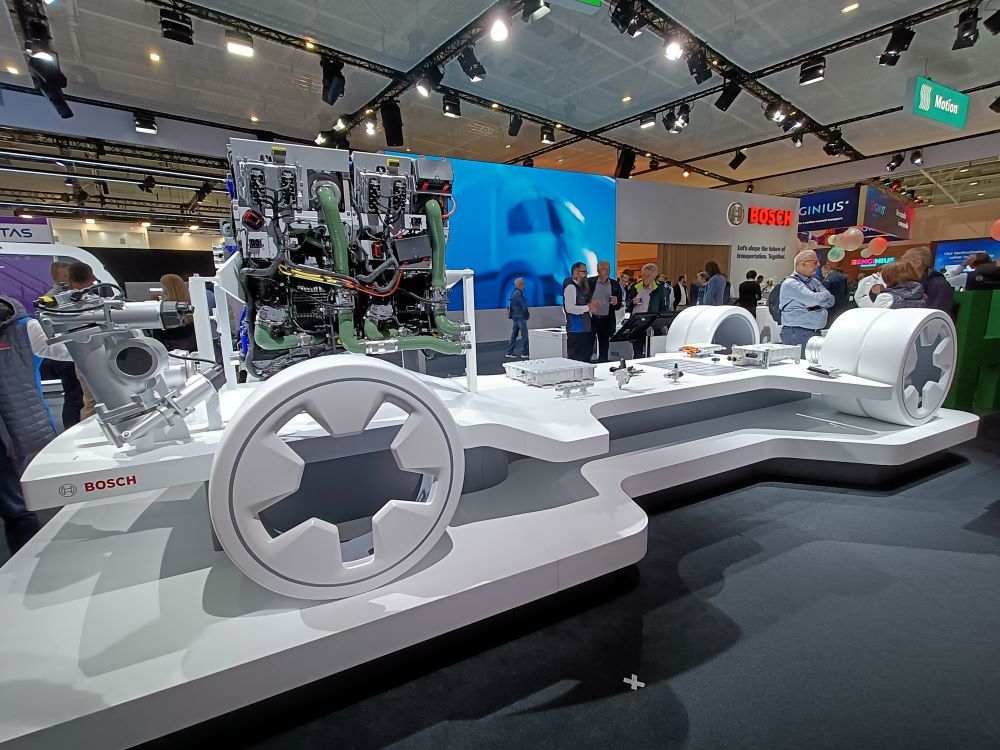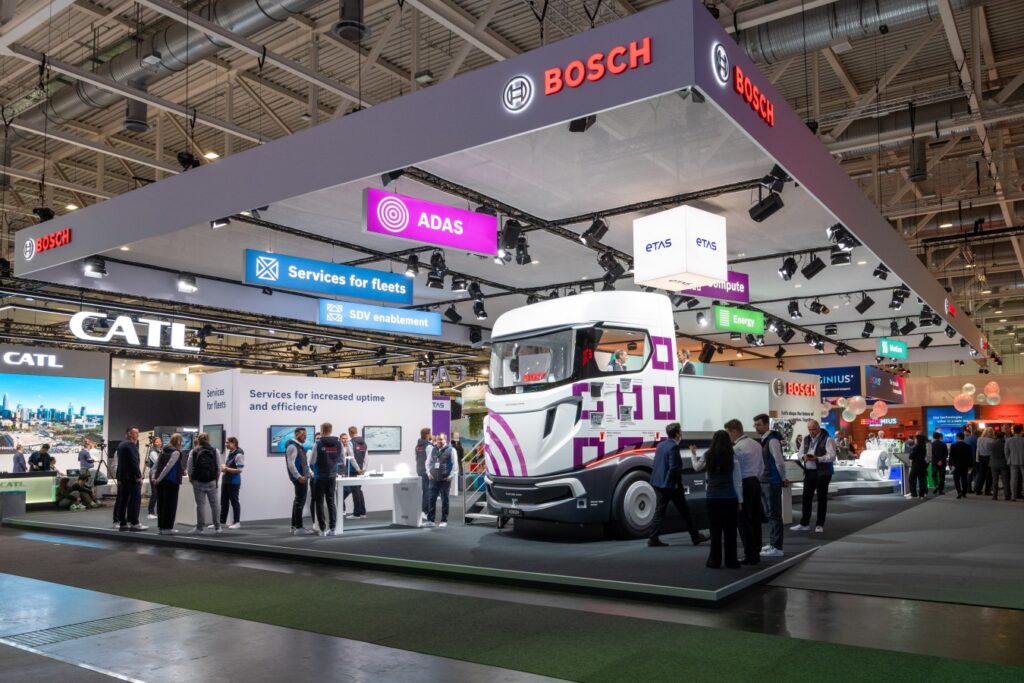
Freight transport is an important pillar of the economy. For their green transformation to succeed, commercial vehicles that transport goods must be equipped with alternative powertrains. As a result, the industry is on the move – and Bosch is leading the way. The technology company is expanding its product and solution portfolio and is once again focusing on diversity. “Commercial vehicles’ transition to alternative powertrains will succeed only if we remain technology neutral and continue to develop all forms of powertrains and make them more efficient,” said Markus Heyn, member of the Bosch board of management and chairman of the Mobility business sector, at this year’s IAA Transportation trade fair in Hannover. “In the coming years, we expect the continuing growth in global freight transport and the simultaneous switch to alternative powertrains for commercial vehicles to drive another surge in growth for our business. For us, our business with big vehicles is anything but a small matter – in Mobility, we generate one-quarter of our sales with trucks and vans,” Heyn said.
Global vehicle production is expected to stagnate in 2024 compared to the previous year. Assuming a good final quarter, the company anticipates slight sales growth at Bosch Mobility in 2024 despite the very challenging market environment. Bosch Mobility aims to achieve global sales of more than 80 billion euros by 2029.

New setup for commercial-vehicle business
Bosch wants to seize the huge opportunities now arising from the growth in global freight transport and the switch to alternative powertrain systems. To that end, the company will be reorganizing its commercial-vehicle business within the Mobility business sector. Starting January 2025, under the leadership of Jan- Oliver Röhrl, executive vice president for commercial vehicles and off-road, the company will pool important competencies in a new business unit, bringing together system development and product and portfolio management for trucks and off-highway applications. “We’re convinced that this new setup will offer benefits to our customers – and that we will collaborate with even greater success as a result. Together, we want to get commercial vehicles on the road even more efficiently and safely,” said Röhrl at IAA Transportation 2024.

To achieve this, Bosch is focusing on powertrain diversity and technology neutrality. According to internal forecasts, the company assumes that, globally, around 20 percent of all newly registered commercial vehicles heavier than six metric tons will have a battery-electric powertrain in 2030, while fuel cells will have a share of around 3 percent. By 2035, a good one in three trucks will have a battery on board, and one in ten will feature a fuel cell. At this point, the hydrogen engine will also be on the road, albeit in smaller numbers. One thing is clear: freight transport can go electric only if the proper infrastructure is in place. “We need a consistent and faster expansion of electric charging stations and hydrogen filling stations in Germany and Europe,” Heyn said.
As Bosch sees it, the various powertrain technologies aren’t in competition with each other – on the contrary: the variety allows manufacturers to decide on the optimum solution for each application. That means Bosch is not only further developing powertrain technologies for batteries, fuel cells, and hydrogen engines, but is also making modern combustion engines even more efficient.

And especially in view of how big the existing vehicle fleet is, synthetic fuels can also play a major part in mitigating climate change.
Assistance systems for commercial vehicles are in the fast lane
At IAA Transportation, Bosch presents its ideas, innovations, and solutions for modern freight transport. But even far away from Hannover, Bosch technology is already changing the way we transport goods from A to B. In China, for example, a Bosch e-axle for heavy commercial vehicles weighing between 18 and 49 tons has gone into volume production – with a fully integrated electric motor, transmission, clutch actuator, inverter, and differential. The solution is suitable for both battery-electric vehicles and vehicles powered by fuel-cell electric modules. In India, the first test vehicles with hydrogen engines are on the road. For these, Bosch supplies injection systems, sensors, tank valves, and control units, including software – all crucial components for hydrogen propulsion. And in the U.S., Bosch and the company FirstElement Fuel are working intensively on something called a cryogenic pump, which will go into operation for the first time in California in 2025. The new pump will make it much easier and, above all, faster to refuel commercial vehicles – with enough hydrogen for 1,000 kilometers of driving in just ten minutes!
The assistance systems business also remains an important part of Bosch’s commercial-vehicle strategy. According to an internal Bosch study, around one in eight accidents caused by a heavy truck can be avoided with the help of the lane-keeping support system – it not only saves lives, but also avoids property damage costs for transport companies. Another key Bosch assistant system is the electronic horizon, which enables fuel-efficient and emission-saving driving for heavy trucks. It collects data on, for example, topography, curve radii, or traffic signs, and intelligently adapts the vehicle’s speed to its surroundings, including by using the truck’s kinetic energy. The system works both on freeways and in urban traffic. For commercial vehicles with combustion engines, it can reduce fuel consumption by up to 5 percent and thus cut CO2 emissions. Electrically powered commercial vehicles have better energy efficiency, which gives them a longer range. More than one million vehicles are already equipped with the Bosch electronic horizon system.
Trucks and vans have to be updatable, too
With the move in the automotive industry toward software-defined mobility, commercial vehicles are also facing a paradigm shift. The growing number of connected services and solutions for fleet management alone makes it crucial for trucks and vans to be updatable, similar to the passenger car sector. Here, the golden rule is to have fewer vehicle computers and hence less complexity in the vehicle’s electrical/electronic architecture. Intelligence is currently distributed across several different computers, but in the future it will be grouped into just a few vehicle computers. Bosch supports manufacturers in the transition from hardware- to software-defined mobility, the commercial-vehicle business included, while offering a wide range of suitable software solutions and services.
Bosch’s digital service platform for logistics, called L.OS, pinpoints and addresses the specific challenges facing the transportation and logistics industry. The company collaborates in this area with Amazon Web Services, among others. At the heart of the software ecosystem for freight forwarders and carriers is a marketplace that offers centralized access to various providers’ digital solutions for all aspects of the logistics business – all in one seamless experience: driver, transport, and fleet management; route planning and parking; financial services and supply chain transparency.
Bosch connectivity solutions also help mobility and logistics service providers to use their vehicles as efficiently as possible and minimize downtimes. The technical basis for this is a Bosch control unit that can be retrofitted to any vehicle regardless of manufacturer, allowing the fleet operator to access its operating and diagnostic data, and thus enabling a wide range of data-based services. The Retrofit Efficiency module (remodul) function, for example, recognizes the route a truck is taking and slightly adjusts its speed in line with empirical values stored in a central database. This can reduce fuel consumption by up to 4 percent – an attractive cost advantage for fleet operators. Vehicle Health, in turn, records both standardized and manufacturer-specific error codes in the vehicle and evaluates them in the cloud. As a result, impending problems can be identified at an early stage and presented in an understandable way so that, for example, early servicing can be suggested. This significantly reduces the number of unexpected breakdowns, thus making it much easier for operators to plan.